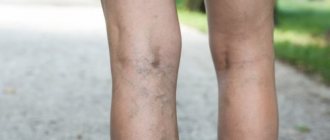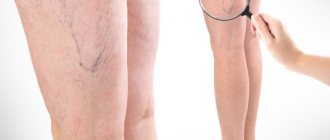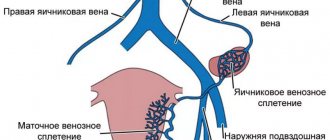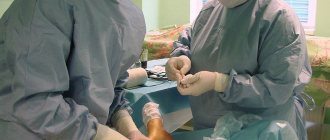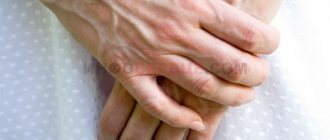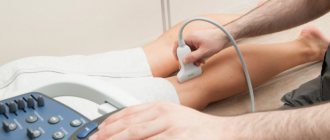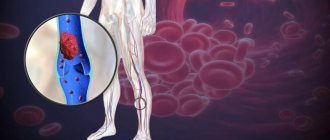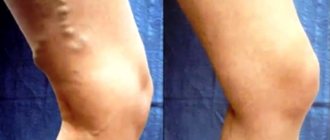Acute thrombophlebitis of the saphenous veins is a vascular pathology in which a blood clot develops in a vein located near the surface of the skin. The disease affects people of both sexes, regardless of age. In most superficial veins with thrombotic changes, an inflammatory process (phlebitis) is present, unlike deep veins.
With superficial thrombophlebitis, the vessels of the lower extremities are most often affected, but similar changes are diagnosed in the veins of the upper extremities, vessels of the penis and mammary gland (Mondor's disease). Thrombophlebitis of the saphenous veins against the background of varicose veins can develop anywhere after medical procedures associated with catheterization of the vein. In most cases, the pathology is benign, but sometimes it can acquire a recurrent course, which leads to the patient’s incapacity.
If the great or small saphenous vein is damaged, thrombophlebitis can spread into the deep venous system. Damage to deep vein valves leads to chronic venous insufficiency (postphlebitic disease) as well as pulmonary embolism, which is associated with a high risk of death.
Risk factors
Predisposing factors for acute thrombophlebitis of the saphenous veins include the following conditions:
- Pregnancy. The increased likelihood of developing thrombophlebitis of the saphenous veins persists throughout most of pregnancy and approximately 1.5 months after birth. This is explained by an increase in platelet stickiness and a decrease in fibrinolytic activity. Women who have a genetic predisposition to hypercoagulation (V Leiden gene, prothrombin C-20210-a) are at particular risk.
- Taking estrogen. Taking hormonal drugs in large doses increases the risk of blood clots by 3-12 times. Low-dose modern oral contraceptives have a much lesser effect on changes in the blood coagulation system.
Other risk factors include:
- varicose veins;
- obesity;
- chronic nicotine intoxication;
- intravenous drug use;
- genetic diseases associated with changes in the blood coagulation system;
- AIDS;
- systemic lupus erythematosus;
- undergoing chemotherapy;
- intravenous catheterization and traumatization during a procedure with intradermal contact of solutions;
- congestive heart failure, etc.
- injury;
- ulcerative colitis;
- treatment with warfarin (the first few days of therapy);
- medical diagnostic procedures (venography), etc.
Conservative method of treating thrombophlebitis
The conservative method involves following certain rules for further effective treatment:
First of all, strict bed rest is necessary; Regular drinking and warm compresses; For certain indications, you can use novocaine blockade - injection with novocaine
Injections are given every six days; Physiotherapeutic treatment is also relevant, especially during the formation of blood clots. If the patient does not have any exacerbations or trophic disorders, resort and sanatorium treatment may be indicated for him; Also, for thrombophlebitis, you need to use anticoagulants (drugs that reduce blood clotting), but with caution, familiarize yourself with all the contraindications of the drugs; The use of hirudinotherapy (treatment with leeches), especially if anticoagulants are contraindicated. Since the existing hirudin in the glands of leeches significantly reduces blood clotting.
For intravenous thrombophlebitis, it is recommended to adhere to a certain diet containing the following components - fruits, vegetables, foods rich in fiber and others.
Symptoms of acute superficial thrombophlebitis
Redness, swelling, hyperpigmentation, visible nodes are signs of acute superficial thrombophlebitis.
Post-traumatic thrombophlebitis
It is characterized by the appearance of a thickened vein after intravenous infusion. The condition may be accompanied by extravasation of blood (bruising, hematoma) as a result of damage to the vein. During the injection of the solution, redness and pain, a feeling of fullness appear, and the compaction itself against the background of edema and hyperemia can be palpated several days or weeks after the infusion. Post-traumatic thrombophlebitis of the superficial veins can develop after sclerotherapy in the treatment of varicose veins or after injury to any varicose veins.
Thrombophlebitis in varicose veins
Superficial thrombophlebitis often accompanies varicose veins. The pathology tends to extend up and down the saphenous vein, but may be limited to tributaries of the main vessel. With varicose veins, trauma does not always act as the initiator of thrombophlebitis.
A sign of superficial thrombophlebitis with varicose veins is the formation of an elastic node surrounded by redness, painful on palpation. Sometimes bleeding develops. Pathology often occurs with varicose ulcers. There is a risk of progression to the deep venous system.
Infectious thrombophlebitis
Infectious thrombophlebitis often develops after intravascular cannulation in weakened patients with concomitant severe inflammatory process in the body. The pathology is characterized by perivascular inflammation with the release of pus into the venous lumen, due to which there is an increased risk of developing septicemia.
Under what circumstances does leg vein thrombosis develop?
In order for a blood clot to form, there must be a blood clotting disorder, a slowdown in blood flow and an inflammatory process in the walls of blood vessels.
But in addition to these reasons, there are risk factors that increase the chances of a blood clot forming in a vein. These include:
- Prolonged bed rest. Some diseases can immobilize a person for some time. In addition, after major surgery, doctors may recommend low activity. In such cases, it is always worth remembering the risk of thrombosis. At the first opportunity, it is necessary to perform at least minimal physical activity to prevent blood clots.
- Pregnancy and childbirth are also dangerous in terms of the development of thrombosis of the veins of the legs. An increase in circulating blood volume, weight changes and increased pressure on the vessels in the pelvic area can trigger the development of a blood clot.
- Injury. In case of a serious injury, a person is not only unable to engage in usual physical activity for a long time, but damage to the vascular wall is also possible. In such cases, the risks increase significantly.
Diagnostics
Visual inspection
Visual manifestations are not the basis for diagnosis, since redness, swelling and pain can occur with a number of other conditions. Edema can be caused by acute venous obstruction due to deep vein thrombosis or the presence of pathological venous reflux in the superficial veins.
In addition, similar clinical signs may occur in cases of liver or kidney failure, cardiac decompensation, infection or trauma. During examination, pay attention to the expansion of the veins on the ankle, lower leg, and popliteal fossa. The color of the vessels is bluish, and reticular patterns (vascular networks) may be present.
Hyperpigmentation or non-healing ulcers are typical signs of chronic venous stasis, especially along the medial malleolus or medial crus. Palpation reveals a thickened, hard vein. Palpable thrombosed vessels are always superficial.
Instrumental and laboratory diagnostics
During an ultrasound examination with Doppler, you can not only confirm the diagnosis, but also measure the speed of blood flow.
Ultrasonography. Duplex ultrasound evaluation is a study that is the gold standard in the diagnosis of superficial vein thrombophlebitis. It is imperative to examine both lower extremities - “silent” thrombophlebitis is very common. Thrombosed veins may appear thickened or inflamed on ultrasound, but loss of elasticity when pressed with the probe head is the main criterion.
This is called a compression test and the tests are called compression ultrasonography. If there are thrombotic masses in the lumen of the vein, the vein will not collapse under compression. The study can also be carried out during pregnancy, as it is absolutely safe. The use of venography has lost its diagnostic value due to many side effects. Duplex ultrasound scanning provides an accurate assessment of the extent of the disease and allows for more rational therapy to be prescribed.
From laboratory tests, evaluation of coagulogram and specific analysis - D dimer may be useful. In a general blood test, an increased number of leukocytes and a high erythrocyte sedimentation rate will indicate an inflammatory process.
How to detect leg vein thrombosis?
In order to diagnose thrombosis of the veins of the legs, the doctor only needs to perform Dopplerography of the vessels of the legs - a method based on ultrasound and the Doppler effect. It takes no more than 20 minutes to examine both legs and determine the exact location of the blood clot in the vein. In this case, the person does not experience any discomfort from the procedure.
In addition to ultrasound diagnostics, a phlebologist may prescribe a blood test for D dimer (a protein that increases in the blood when a blood clot disintegrates). This indicator is very sensitive, but can increase not only with thrombosis, but also with other pathologies. Therefore, you cannot focus only on it; a comprehensive examination is necessary.
Treatment of acute thrombophlebitis of the saphenous veins
The absolute indication for surgical treatment is the location of thrombotic masses less than 3 centimeters to the ostial valve of the great saphenous vein or the junction of the small saphenous vein under the superficial fascia of the leg.
This is determined by the location of the thrombotic on the basis of ultrasound examination of both lower extremities.
Conservative treatment
Anticoagulants are decisive in the treatment of superficial vein thrombophlebitis.
- Anticoagulants Arixtra (fondaparinux) - low molecular weight heparin in a dosage of 2.5 ml. once a day for 45 days. The main role of direct anticoagulants is to dissolve thrombotic masses and prevent the formation of new ones. Fresh blood clots are much more dangerous in the development of such a serious complication as pulmonary embolism, which leads to the sudden death of patients.
- Class 2 compression therapy Specialized compression stockings of the second class of compression 24-32 mm are used. rt. Art. whose function is to compress the superficial veins and increase the speed of blood flow in the deep veins.
After confirming the diagnosis of thrombophlebitis of the saphenous veins, the compression stocking is worn for 7 days, then it can be removed at night for another month.
- NSAIDs (ibuprofen, indomethacin, naproxen, etc.) are prescribed as drugs that have anti-inflammatory and analgesic effects at the same time.
- Phlebotonics (detralex, venosmil, cyclo 3 fort, etc.) The main effect is to strengthen the vascular wall, prevent complications in the pre- and postoperative period, improve blood circulation and lymphatic drainage, and have an indirect anti-inflammatory and analgesic effect.
- Means for local therapy. The bioavailability of medicinal substances from topical use of gels and ointments is low, so using them as the only drugs is unacceptable. As part of complex therapy, in combination with cold, they reduce symptoms. Local therapy is based on anti-inflammatory gels (Voltaren, Diclak, Fastum Gel, etc.) Apply for 7 days three times a day locally to the inflamed area of the vein until the redness of the skin disappears.
Surgery
Palliative operation: crossectomy - ligation of the mouth of the great or small saphenous veins in front of the ostial vein. This intervention is performed under local anesthesia, preferably by an experienced surgeon.
In patients with frequent relapses of the pathology or when the process has spread, the modified vein can be excised. Urgent surgery is necessary for the septic form of thrombophlebitis and the proximity of thrombotic masses to the ostial valve.
Surgical treatment may also be considered for patients with saphenous vein thrombophlebitis, especially if the process extends upward to the femoral or popliteal vein despite anticoagulant therapy, or if there are contraindications to such therapy. In such cases, crossectomy is complemented by deep vein thrombectomy.
Varicose veins, thrombophlebitis
Varicose veins are a disease of the veins, characterized by an increase in their size, a change in shape and a decrease in elasticity. Mostly the superficial veins of the lower extremities, the venous plexus of the rectum, the veins of the portal system and the spermatic cord are affected. The development of varicose veins is facilitated by difficulties with the outflow of blood through the venous system during systematic long-term standing on the feet associated with professional activities, compression of the pelvic veins by the uterus during pregnancy, congestion in the pelvic veins, for example, with systematic constipation, sedentary work, etc. Sitting slows down blood circulation and makes the blood stagnant. Long periods of inactivity and sitting can damage the heart of people who sit for long periods of time and may develop thrombosis in the deep veins of the calves. It is harmful to sit with your legs crossed, since you can press on the popliteal artery, which will cause stagnation in the veins.
Clothes and shoes should not be tight; this can also slow down blood flow. Walking on grass, dirt, or just barefoot around the house improves circulation and strengthens the heart. The disease is predisposed by congenital weakness of the venous wall and insufficiency of the venous valves. Due to poor blood supply to the veins, ulcers may appear over time.
One of the early symptoms of the disease is a feeling of heaviness in the legs at night, dull or sharp pain and cramps. If varicose veins are left untreated, the veins become hard and dense over time, and ulcers and bleeding often appear on the legs.
Varicose veins that form in the scrotum are called varicoceles (varicose veins of the spermatic cord). If they appear in the rectum, they are called hemorrhoids.
Phlebitis (inflammation of the veins) , varicose ulcers, severe scratching, and discoloration of the skin (which often turns coppery red) are common complications of this condition. But only a small percentage of those who have varicose veins develop varicose ulcers. It is believed that people with varicose veins have congenital veins with weak vessel walls. But weak vessel walls are most likely a consequence of poor nutrition, toxemia, innervation (decreased nervous condition) and lack of exercise. In most cases, when varicose veins form during pregnancy, they disappear after childbirth. With the help of sufficiently active physical exercise, varicose veins that occur during pregnancy can be eliminated even when the woman is pregnant.
Surgeries to remove or drain veins are not successful. The use of elastic stockings or bands to support the veins is merely a half-measure and ultimately leads to such weakening of the tissue that the condition becomes chronic or much more difficult to treat.
To prevent varicose veins, you should:
- avoid prolonged sitting in one position to avoid muscle stiffness, and long standing;
- do physical exercises for your legs every day: rise on your toes more often, climb stairs on foot, swim, walk 1-3 km, stay in a pose with your legs raised above heart level for at least an hour;
- do not gain excess weight.
Recipes
— Mikulin’s exercises are very effective for clearing blood vessels: rise on your toes so that your heels lift off the floor by 1-2 cm, and then sharply lower yourself onto them. After doing this 30 times, rest for 10 seconds. The exercise should be performed calmly, slowly, 3-5 times a day, making no more than 60 hits of the heels on the floor each time.
— Fill a half-liter bottle with birch buds to 1/3 of its volume and fill it with vodka to the neck. Leave for 10 days, shaking occasionally. Apply this tincture to sore areas.
— Rinse 3 medium-sized Antonovka apples with cold water. Place them in an enamel bowl and pour 1 liter of boiling water. Leave for 3 hours, tightly wrapped. Then crush the apples and strain the resulting infusion. Drink 50 ml daily. in the morning on an empty stomach and in the evening before bed. Prepare the infusion and take until the condition improves.
— When treating vein blockage, you need to simultaneously take baths and drink decoctions of various medicinal plants: chamomile, string, oak branches, chestnut, willow. For baths: take 500 g (in winter - 300 g) of oak branches and the same number of chestnut and willow branches, put in an enamel bucket, fill with cold water, bring to a boil and boil for 30 minutes. Then add 200 g of herbs: marshweed, string, chamomile, St. John's wort and leave overnight. Separately, boil or steam 3 loaves of rye bread and pour the broth into the bath. Baths should be taken daily before bed for 30-40 minutes. at 38-43°C. At the same time, you need to brew 1 liter of boiling water with a mixture of 1 tbsp. l. oak branches, 1 tbsp. l. willow branches and 1 tbsp. l. chestnut branches, boil for 30 minutes, add 1 tbsp to the broth. l. herbs: marsh cudweed, string, chamomile, St. John's wort, leave for 12 hours, strain and add 2 tbsp. l. honey Drink 2-3 times a day, in the first 2 days 50 ml, then 2 days 100 ml. other days 150 ml. The course of treatment is 20 days, break is 5-10 days. And repeat the course of treatment again.
- For varicose veins and thrombophlebitis: grind into powder plantain leaves, flowers of rue officinalis and yarrow, white willow bark (preferably cambium), chestnut fruits or flowers, marshmallow or raspberry root (flowers and even leaves are possible) and chamomile, taken in equal measure proportions, mix thoroughly, brew 600 ml of boiling water 2 tbsp. l. mixture, bring to a boil and immediately remove from heat, and then leave overnight. Drink 3/4 glass in the morning and evening. Make a compress from the remainder for the night.
— Thrombophlebitis can be cured by taking an infusion of nettle leaves and following a diet (do not eat meat, fish, anything fried) for a long time. Nettle infusion: 1 tbsp. l. Brew the leaves with a glass of boiling water, leave for 40 minutes, strain. Drink 1-2 tbsp. l. 3-4 times a day before meals.
— For varicose veins: 2 times a day, morning and evening, rub apple cider vinegar on all affected areas and at the same time drink apple cider vinegar: 2 tsp. for 1 glass of water, 2-3 glasses per day.
- Abundant wetting and rubbing with alcohol tincture of white acacia flowers resolves swollen venous nodes well.
— For varicose veins, baths made from a decoction of willow bark are useful: brew 2 handfuls of bark with 5 liters of boiling water, put on low heat and heat for 30 minutes, strain.
— For thrombophlebitis: apply compresses from a decoction of bodyaga to the sore spot 1-2 times a day for 1.5-2 hours. Brew 0.5 liters of boiling water, 2 tbsp. l. bodyagi, leave for 2 hours.
— A decoction of oak bark has a strengthening effect, like resin, on internal blood vessels. 1 tbsp. l. Brew the bark with 1 cup of boiling water, heat over low heat for 25 minutes, leave for 40 minutes, strain. Drink 1 tbsp. l. Three times a day before meals.
— Brew 1 cup of boiling water 1 tbsp. l. crushed leaves or hazelnut bark and leave for 6 hours. Drink 3/4 cup 3-4 times a day for 30 minutes. before meals for a month.
- Pour 1 glass of vodka into 2 tbsp. l. crushed fresh Kalanchoe leaves and leave for a week. Rub this tincture on the feet affected by the disease for a month.
- Thoroughly grind freshly picked leaves and heads of silver wormwood in a mortar, mix 1 tbsp. l. prepared raw materials and 1 tbsp. l. sour milk or sour cream, apply an even layer on gauze and apply this gauze to areas with dilated veins for 1.5-2 hours. Such dressings should be applied for 4-5 days. After 2-3 days, treatment can be repeated.
— For varicose veins: walk in the early morning, before sunrise, in clean cotton socks on the dewy grass so that the socks are well saturated with water. When the sun rises, you need to walk around in these socks, without taking them off until they dry.
— Exercises: lying down, raise your right leg up, relax it as much as possible and sharply shake your foot. Lower your leg. Do the same with the other leg. Repeat 10-20 times. And so - several times a day. The bigger, the better. Walking and moderate exercise are the best prevention against varicose veins. From time to time it is necessary to take the “legs above head” position. In general, all exercises with leg lifts are useful.
— For dilated veins and pain in the legs, use warm foot baths (up to the knees) from a decoction of oak bark for 30 minutes. After the bath, put on rubber elastic stockings and be sure to rest.
— For varicose veins, thrombophlebitis, infuse 38 g of fresh burdock roots in 100 g of sunflower oil for 24 hours, then cook over low heat for 15 minutes, strain and lubricate the wounds.
— 10 g of calendula flowers, pour 100 ml of olive oil, shaking regularly, leave in the sun for 20 days, then strain. Lubricate the affected areas of the skin.
— There is another ointment recipe: mix 10 g of dried calendula inflorescences crushed into powder with 50 g of petroleum jelly.
— An alcohol tincture of calendula flowers and flower heads is prepared in 70° alcohol in a ratio of 1:10. When using, dilute 1 tsp. in a glass of water.
- Birch leaves, sweet clover grass, wild strawberry leaves, meadowsweet grass, mantle leaves, oat straw, dandelion root - take everything equally. Pour 8 g of the collection into 350 ml of boiling water, heat in a water bath for 10 minutes and leave warm for 30 minutes, then strain. Take 0.5 cups in body form 3 times a day, 20 minutes after meals.
- Birch leaves, cornflower flowers, peppermint grass, sweet clover grass, hazelnut leaves, shepherd's purse grass, chicory root - take everything equally. Pour 8 g of the collection into 350 ml of boiling water, heat in a water bath for 10 minutes and leave warm for 30 minutes, then strain. Take 0.5 cups in body form 3 times a day, 20 minutes after meals.
- 1 tbsp. l. Brew ground pine needles in 0.5 liters of boiling water and leave for 1 hour. Drink at least 0.5 cups daily.
- Rinse 3 medium-sized apples (preferably Antonovka) with cold water, place in an enamel bowl and pour 1 liter of boiling water. Wrap tightly in a blanket, cover with a pillow and leave for 3 hours. Then crush the apples and strain the resulting solution. Take 50 g daily in the morning on an empty stomach and in the evening before bed (the infusion is enough for 5-6 days). Take until improvement occurs.
— Fill a half-liter bottle one-third full with birch buds and pour vodka into it up to the neck, shake occasionally. Leave for 10 days. Lubricate the veins when your legs begin to hurt and rest for 10-15 minutes. Then lubricate again and stop all physical activity. This tincture helps with thrombophlebitis and all non-healing wounds.
— A decoction of carrot tops should be drunk instead of tea or water constantly.
— Bodyag, or sow thistle, often eliminates the need for surgery for varicose veins. 30 g of bodyag stems and leaves are poured into 300 ml of water, boiled over low heat for 5 minutes, and cooled. Compresses are best done at night.
- Lubricating varicose veins and nodes with 6 percent apple cider vinegar reduces the dilation of veins.
- 1 tbsp. l. Grind the common hop cones, pour a glass of boiling water and heat in a water bath for 15 minutes. Drink the decoction before meals 3 times a day, 200 ml. It should be remembered that hops have a hypnotic effect, which is important for drivers to know. Hop decoction can be used for external use by applying napkins with it to areas with dilated veins for 10-15 minutes.
— Infuse 50 g of chestnut flowers in 0.5 liters of wheat vodka in a dark place for 14 days, shaking occasionally. Strain and drink 3 times a day, 30-40 drops, 20 minutes before meals. The course of treatment is 3-4 weeks. At the same time, lubricate the affected areas several times a day with ointment: mix 10 g of chamomile flower powder, sage leaves and flowers, 50 g of mashed chestnut fruit and 5 g of potato starch. Pour the mixture into 200 g of hot chicken fat, simmer for 2.5 hours in a water bath, leave overnight, heat again to a boil, strain, squeeze and cool.
— Take an infusion of nettle leaves for varicose veins for a long time, while following a diet: do not eat meat, avoid fried foods.
— Decoction of hazel bark (hazel). 1 tbsp. l. crushed bark, pour 0.5 liters of boiling water, cook for 10 minutes, strain. Drink 0.5 cups 4 times a day before meals.
- Watch leaves, knotweed grass, oregano grass, willow bark, clover flowers, juniper fruits - all equally. Pour 8 g of powdered collection into 250 ml of boiling water, boil for 5 minutes, leave in a thermos for 2 hours, then strain. Take warm, 0.3-0.5 cups 3 times a day after meals.
— Before going to bed, it is useful to take foot baths in an infusion of the herb cudweed. Bath temperature is 38-39°C.
— A decoction of oak bark has a strengthening effect on blood vessels. 1 tbsp. l. bark, pour 1 cup of boiling water, heat over low heat for 25 minutes, leave for 40 minutes, strain. Drink 1 tbsp. l. 3 times a day before meals.
— Taking 5-6 balls (the size of a grain of rice) orally for some time during the day, spruce or pine resin, strengthens the internal blood vessels (the balls will be digested).
- 1 tbsp. l. crushed leaves or hazelnut bark, pour 1 cup of boiling water and leave for 6 hours. Drink 3/4 cup 3-4 times a day 30 minutes before meals for a month.
- 2 tbsp. l. crushed fresh Kalanchoe leaves, pour 1 glass of vodka and leave for a week. Rub this tincture on the feet affected by the disease for a month.
- Thoroughly grind freshly picked leaves and heads of silver wormwood in a mortar, mix 1 tbsp. l. prepared raw materials and 1 tbsp. l. sour milk or sour cream, apply an even layer on gauze and apply this gauze to areas with dilated veins for 2 hours. Such dressings should be applied for 4-5 days. After 2-3 days, treatment can be repeated.
— Take herbal mixtures in courses of 2-2.5 months, changing the collection of herbs after each course.
- Grate a large fresh potato on a coarse grater. Place the pulp on a gauze napkin, place it on the diseased vein, cover with plastic wrap or compress paper and tie with a scarf. Apply compresses daily at night. The course of treatment is two weeks. If necessary, after a week's break it can be repeated.
- Apply a 1 cm layer of freshly grated potato gruel to the ulcers. Cover the top with 6 - 8 layers of gauze for 4-5 hours. Replace the gruel with a new one or moisten a gauze napkin with the juice of grated potatoes.
- Steam your feet in hot water and cover them with fresh washed lilac leaves. You can make a poultice from fresh leaves or their strong decoction.
— Horse chestnut is used for varicose veins, thrombophlebitis, leg ulcers, as an anti-inflammatory agent. Preparation of an alcohol-water solution: 50 flowers or crushed fruits are infused in 0.5 vodka for 14 days. Drink 30-40 drops 3-4 times a day for 4 weeks with water. The infusion is also used for external treatment in the form of compresses and rubbing.
- For thrombophlebitis and varicose veins, pour 200 g of marshweed grass into a bucket of boiling water, leave for 30 minutes and immerse the affected limb in still hot water. Keep for 30 minutes, adding hot water little by little.
— For thrombophlebitis 1 tbsp. l. Grind the hop cones, pour 200 ml of boiling water and heat in a water bath for 15 minutes. Take 1 glass 3 times a day before meals. Apply compresses with the resulting infusion to the affected areas of the legs.
— For chronic ulcers on the legs without exacerbations, lubricate them with a 5% solution of mumiyo in aloe juice (or even better with aloe ointment), i.e., take 5 g of mumiyo per 100 g of aloe juice or ointment. And in warm weather it is better to cover this lubricant with a plantain leaf, in cold weather - with a cut of an aloe leaf or a piece of parchment paper, and lightly bandage it all for a day. After a day, replace the mummy compress with St. John's wort oil, the flowers of which are infused for 15 days in sunflower, or better yet, castor oil (1 tablespoon of flowers per 1/2 cup of oil). After 15 procedures, it is better to replace St. John's wort oil with 5% ointment made from sea buckthorn oil: 5 g of oil per 100 g of aloe ointment.
- If there is neither St. John's wort nor sea buckthorn, and even if they are present, use 25% carotolin ointment. It can be prepared from rose hip pulp, crushing dry berries, using aloe ointment or vegetable oil in a ratio of 1:4. Even better is to use rosehip seed oil.
— For ulcers on the legs: brew 1 cup of boiling water, 1 tsp. dill seeds and leave, wrapped, for 1 hour. Drink 0.5 cups 3 times a day. The course of treatment is 1 month.
- The most effective lubrication of ulcers is mummy with aloe juice or aloe ointment. A course of treatment requires at least 15 such lubrications, repeating the course after 1-1.5 months.
— Infusions of tricolor violet (pansy) and chamomile improve skin trophism. After 1 month of such lotions, it is useful to lubricate the skin with propolis ointment.
— For ulcers on the legs, it is recommended to make medicinal dressings from an aqueous infusion of fruits or sea buckthorn oil.
— As a compress, apply crushed fresh cabbage leaves mixed with egg white to the sore spots.
— Apply fresh crushed celery leaves to the wounds or use celery ointment consisting of crushed celery leaves and fresh butter or sunflower oil.
- For leg ulcers, rub rosehip oil, St. John's wort or sea buckthorn oil into the sore spots at night.
— For ulcers, drink burnet infusion: pour 2 tbsp. l. crushed root 0.5 liters of cold boiled water, leave for 8-10 hours and take 1 tbsp. l. 3 times a day before meals. The duration of treatment is up to one month.
— Place green walnuts in a bowl, pour olive or sunflower oil over them and place in the sun for 40 days. It is recommended to lubricate the sore areas with the resulting ointment until it runs out.
— For ulcers on the legs: apply crushed fresh or steamed plum leaves to the affected areas.
— 10 g of fresh flowers or 5 g of dried acacia bark, infuse for 10 days in 100 ml of vodka. Moisten and rub the swollen venous nodes with the tincture, they will dissolve well.
Recipes from T. N. Yukalo
— An infusion of dried nettle is used for varicose veins. Dry crushed leaves of the plant are poured into a thermos with 1/2 liter of boiling water, left for 30-40 minutes, filtered and taken 1/3 cup 3 times a day 1 hour after meals.
— Apple cider vinegar increases blood clotting, restores the menstrual cycle, promotes the functioning of blood vessels and the formation of red blood cells. It is used for varicose veins: it is applied to the affected areas every morning and evening, while drinking 2-3 glasses of water with the addition of 2 teaspoons of vinegar to each glass.
— Ulcers formed as a result of varicose veins are treated with fresh potatoes. Apply a 1 cm layer of grated potato gruel to the ulcer. Cover the top with several layers of gauze for 4-5 hours. Then replace the gruel with a new one or moisten a gauze napkin with fresh potato juice.
— Tincture of white acacia flowers is used as an external remedy for thrombophlebitis, as well as for radiculitis, rheumatism, salt deposits, and bruises. Lubricate and rub the affected areas generously.
— Crush a tablespoon of hop cones, pour 200 ml of boiling water and heat in a water bath for 15 minutes. Take a glass 3 times a day before meals. On the area of the legs with dilated veins, apply gauze soaked in hop decoction.
— When dilating veins, you can use Kalanchoe leaves. Prepare a tincture from them: take a half-liter bottle, fill it halfway with chopped leaves, fill it to the top with 40% alcohol, leave for 7 days in the dark, shaking occasionally. Then strain and rub this tincture on your feet overnight. You need to rub it in with massaging movements from bottom to top for 4 months.
— Lightly beat off a leaf of white cabbage and roll it thoroughly with a rolling pin. Grease one side of the sheet with vegetable oil and apply this side to the area of the body affected by thrombophlebitis. Secure with a bandage and keep this compress for a day. The course of treatment is 1 month.
— An infusion of Antonov apples cleanses the blood during thrombophlebitis, improves sleep and appetite. Rinse three medium-sized apples with cold water and place on the bottom of an enamel pan. Pour 1 liter of boiling water over the apples, close the pan with a lid, wrap it in a blanket and after 4 hours, without removing the apples from the cooled water, mash them in the pan. Strain the resulting infusion and drink with honey: take a teaspoon of honey with 50 ml of infusion. Take in the morning on an empty stomach and before bed.
— Pour 500 ml of boiling water over a tablespoon of crushed hazel bark, boil for 10 minutes, strain. Take 1/2 cup 4 times a day before meals for varicose veins, periphlebitis, leg ulcers, capillary hemorrhoids.
- Mix in the indicated proportions: chamomile flowers - 2 parts, tricolor violet herb - 1 part, horsetail herb - 1 part, St. John's wort herb - 2 parts, yarrow herb - 1 part, calendula officinalis flowers - 2 parts, oak bark ordinary - 1 part. Pour a tablespoon of the mixture into a glass of boiling water, leave for 30 minutes, strain. Use as a compress to wash trophic ulcers for several days in a row.
— Cut unripe (green) walnuts, pour into a jar, pour olive oil and place in a sunny place for 40 days. Apply the prepared medicine to the sore areas for a long time.
— Take celandine tincture at the rate of 9 drops per 1 tablespoon of milk 3 times a day before meals.
- Grind fresh leaves and inflorescences of wormwood thoroughly in a mortar. Mix a tablespoon of the resulting slurry with a tablespoon of sour milk. Stir and apply in an even layer on gauze, which is then applied to areas with dilated veins. Treatment is carried out for 3-4 days, repeat after a few days.
- 100 g of dry crushed herb of fragrant rue, pour 0.5 liters of vodka and leave for 10 days in a dark place. Take 10 drops per tablespoon of water 3 times a day.
- 100 g of dry herb, pour 5 liters of boiling water, leave for 10 hours. Use the infusion for a foot bath (37 °C) for 20-30 minutes.
— For foot baths, a decoction of white willow (willow) bark is used. Pour two tablespoons of crushed bark into 2 cups of boiling water and simmer for 15-20 minutes over low heat. The duration of the bath is 0.5 hours. After the bath, put on thick elastic stockings and rest your feet. You can also use a mixture of willow bark and oak bark.
— 250 g of peeled and grated garlic, pour 350 g of liquid honey, mix thoroughly and leave for a week. Take 1 tablespoon 3 times a day 40 minutes before meals. The course of treatment is 1-2 months. Use for vascular diseases of the legs.
— Cut a well-ripened tomato into slices and apply them to the dilated veins. After 3-4 hours, add fresh slices.
— Fill a half-liter bottle 3/4 full with birch buds and add vodka. If pain occurs, lubricate the sore spot with the tincture. After 15 minutes, repeat the procedure and give your legs a rest.
Diet.
The famous Indian doctor H. K. Bakhru recommends that patients undergo a four-to-five-day juice fast or a fruit diet for 7-8 days at the beginning of treatment. Then gradually move to a balanced diet with an emphasis on grains, seeds, nuts, raw vegetables and fresh fruits. All seasonings, alcohol, coffee, strong tea, white flour, white sugar and confectionery products should be excluded from the diet.
A short-term juice fast or fruit diet for 2-3 days can be repeated monthly, depending on the results.
For thrombophlebitis, cranberries, blueberries, sea buckthorn, and figs are especially indicated.
Middle-aged people and old people suffering from varicose veins benefit from nettle infusion, which is consumed without strict dosage and drunk as tea. A soup is prepared from spring nettle, which helps rejuvenate the body and improve the functioning of its most important organs.
For varicose veins you can use:
— All kinds of fruit and vegetable crops, herbs, greens. It is very useful to eat vegetable salads seasoned with vegetable oils and apple cider vinegar. The latter, by the way, is itself a medicinal drug that helps with vascular disease in the legs; it is used both internally and externally.
— Lean meats: lean beef, chicken breast, turkey. Meat products should be prepared with a low fat content, preferring stewing and steaming. It will be very tasty and healthy to bake a piece of lean meat in the oven with herbs and a small amount of vegetable oil.
- Seafood. These include mussels with octopus and seaweed, especially seaweed. Such food is indispensable due to its high iodine content, which is responsible for the functioning of the thyroid gland - the main regulator of the body's hormonal levels. Nuts containing increased amounts of healthy vegetable fats and proteins are a necessary component of the diet. Vegetable fats and proteins, unlike animals, do not harm the body with varicose veins.
- Cereals, grains, bran. Source of coarse fibers and natural antioxidants.
- Various berries - cherries, cherries, strawberries, gooseberries - are a storehouse of ascorbic acid, which thins the blood very well.
— Purified water without gas, herbal and green tea, fruit and herbal infusions. You need to drink more often, bringing your daily fluid intake to one and a half to two liters. To improve the taste and provide benefits, all drinks can be flavored with honey.
Varicose veins require many dietary restrictions. Excluded from the diet:
- Alcohol, strong tea and coffee. “Champions” among blood thickeners and products that cause vascular spasms.
— Semi-finished products generously flavored with preservative chemicals, sparkling water, smoked meat, fish, sausages. Actively and quickly create excess cholesterol in the blood.
— Strong, rich soups and broths, aspic, will also saturate the blood with unnecessary cholesterol and deprive the vein walls of the necessary elasticity.
— Pickles (marinades, vegetables in marinade), canned vegetables (including homemade), just food with excess table salt. Avoid completely, because nutrition for varicose veins is aimed, among other things, at eliminating swelling of the legs.
— Fatty and sweet confectionery products. In addition to cholesterol, which is generously formed in the blood as a result of the presence of these products on the menu, a side effect for those with a sweet tooth is extra pounds. And this, as we remember, is pressure on the veins, thick blood and the risk of blood clots.
Forecast
The prognosis for acute thrombophlebitis of the saphenous veins with varicose veins is favorable only if timely adequate anticoagulant treatment, prophylactic use of phlebotonics, wearing compression stockings, a balanced diet and feasible physical activity (without lifting heavy objects).
Timely planned phlebectomy (classical or minimally invasive) will limit a patient with varicose veins from a deadly complication such as thrombophlebitis of the saphenous veins (varicothrombophlebitis).
Surgical method for treating thrombophlebitis
You need to understand that not every blood clot can be fatal. Most patients with this diagnosis are treated on an outpatient basis. For superficial thrombophlebitis, the use of special compresses is important. In case of thrombophlebitis, the removal of varicose nodes is carried out by professional doctors (phlebologists) using the method of surgical intervention by removing blood clots through punctures.
If the risk of a blood clot breaking off and penetrating into a deep vein remains, then the trunk of the superficial vein is surgically ligated in the area where it joins the deep vein. With this action, surgeons prevent the blood clot from entering the organ through the bloodstream.
Subtleties of diagnosis
Making a correct diagnosis is not difficult, since each pathology has a specific clinical picture.
Thrombophlebitis of the venous nodes is accompanied by an increase in body temperature, pain, and redness. Due to the risk of a threat to life, the patient needs urgent consultation with a phlebologist or surgeon for emergency treatment. The affected vein in thrombophlebitis is tense and inflamed, in contrast to varicose veins, in which there is no redness and inflammation.
Diagnosis of vascular pathology is carried out using a special method of ultrasound angioscanning. It determines the condition of the venous walls, assesses the nature of the thrombus, its size and boundaries.
Main symptoms of thrombophlebitis
The main symptoms of thrombophlebitis are:
- nagging pain in the affected limb;
- pain on palpation;
- swelling in the legs;
- muscle pain;
- change in skin color (pallor or cyanosis);
- increase in body temperature (in the acute period).
So, we’ve sorted out the main symptoms and classification. A doctor will prescribe drug treatment for thrombophlebitis, but you can turn to traditional doctors and choose for yourself ways to treat thrombophlebitis at home.
But we want to warn you in advance - if you decide to treat thrombophlebitis with folk remedies, then any of the chosen methods should be agreed with your doctor. After all, folk remedies, just like medications, may have their contraindications.
Now let us dwell in more detail on the methods of treating thrombophlebitis and varicose veins, depending on its location.
Aseptic thrombophlebitis of the upper extremities
The appearance of aseptic thrombophlebitis is most often associated with medical procedures. It occurs as a result of intravenous infusions over a long period of time.
The risk of aseptic thrombophlebitis is especially high if the same vein is used all the time for infusions of antibiotics and hypertonic solutions.
Aseptic thrombophlebitis of the upper extremities, treatment involves the following:
- Stop all intravenous procedures.
- Topically apply the drugs Butadione, Troxevasin, Venoruton.
- A complex of physical procedures – magnetic therapy, laser therapy.
It should be noted that thrombophlebitis of the upper extremities is quite rare; the vessels of the lower extremities are more often susceptible to it.
Thrombophlebitis during pregnancy
Due to the increase in body weight of a pregnant woman, the load on the lower limbs increases. Often the result of such increased load is thrombosis of the veins of the lower extremities. If thrombophlebitis appears in the 3rd trimester of pregnancy, the pregnancy will most likely be maintained.
